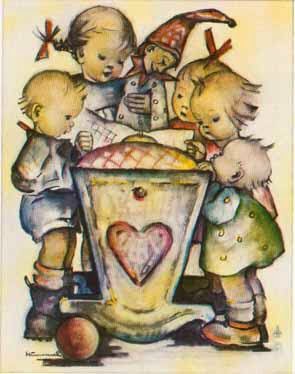nPostednon May 21, 2014
n
n
n
n
n
nHere’sna nice change: a story of an artist whose life was mostly verynpleasant and nice.
n
nUntil Hitler and World War II, that is. But we’ll get to that later.
n
n
n
n
n
n BertanHummel was born in Bavaria, Germany. Her family was large and lovingnand happy, two parents and six kids living above the dry goods storenthat was the family business.
BertanHummel was born in Bavaria, Germany. Her family was large and lovingnand happy, two parents and six kids living above the dry goods storenthat was the family business.
 BertanHummel was born in Bavaria, Germany. Her family was large and lovingnand happy, two parents and six kids living above the dry goods storenthat was the family business.
BertanHummel was born in Bavaria, Germany. Her family was large and lovingnand happy, two parents and six kids living above the dry goods storenthat was the family business.n
n
n
n
n
nBavarianis beautiful mountain country – the Alps! – and Hummel was ancheerful girl who loved the outdoors as well as drawing. The townnthought of her as “the artist,” and she ended up going to thenAcademy of Applied Arts in Munich.
n
n
n
n
n
n Hummelnwas very religious and decided to become a nun. As Sister MarianInnocentia (her religious name), Hummel taught art to children. Butnshe continued to make her own original art, too, and the other nunsnsent it out to a company for possible publication. n
Hummelnwas very religious and decided to become a nun. As Sister MarianInnocentia (her religious name), Hummel taught art to children. Butnshe continued to make her own original art, too, and the other nunsnsent it out to a company for possible publication. n
 Hummelnwas very religious and decided to become a nun. As Sister MarianInnocentia (her religious name), Hummel taught art to children. Butnshe continued to make her own original art, too, and the other nunsnsent it out to a company for possible publication. n
Hummelnwas very religious and decided to become a nun. As Sister MarianInnocentia (her religious name), Hummel taught art to children. Butnshe continued to make her own original art, too, and the other nunsnsent it out to a company for possible publication. nn
n
n
n
n
n
n Indeed,nthe company was very interested. At the time, in the early 1930s,npostcards with artwork were very popular, and the company releasednmany of Hummel’s drawings as postcards. It also published ancollection of her drawings.
Indeed,nthe company was very interested. At the time, in the early 1930s,npostcards with artwork were very popular, and the company releasednmany of Hummel’s drawings as postcards. It also published ancollection of her drawings.
 Indeed,nthe company was very interested. At the time, in the early 1930s,npostcards with artwork were very popular, and the company releasednmany of Hummel’s drawings as postcards. It also published ancollection of her drawings.
Indeed,nthe company was very interested. At the time, in the early 1930s,npostcards with artwork were very popular, and the company releasednmany of Hummel’s drawings as postcards. It also published ancollection of her drawings.n
n
n
n
n
n
n
nEnternFranz Goebel; he owned a porcelain company, and he was on the lookoutnfor art he could translate into figurines. He loved Hummel’s picturesnof rosy-cheeked children, and he asked if he could have the rights tonthe drawings for manufacturing as figurines. n
n
n
n
n
n
n
n
n
n
n
n
n
n
n
n
n
n
n
n
n
n
n
n
n
n
n
n
n
n
n
n
n
n
n
n
n
n
n
nThenfigurines began to be a big financial success, and I read in onensource that the Hummel figurines were the main source of income fornall of the Sisters.
n
n
n
n
n
nButnit was at this point that Hitler comes into the story. And of course,nthe story turns from happy and successful to difficult and tragic:
n
n
n
n
n
nHitlernapparently hated Hummel’s art and said that she was presenting thenworld with a picture of German children having “hydrocephalicnheads.” (Hydrocephalus is medical condition that can causenenlargement of the head.) The Nazis allowed Hummel to work and tooknhalf of the money generated from the work – but they wouldn’t allownanyone in Germany to sell or buy the figurines. And the Nazis seizednthe convent and forced most of the Sisters to leave; those whonremained were forced to live in one small section of the conventnwithout heat. Food was scarce, and the nuns relied on the Hummelnsales (after the Nazis got their cut) for the little bit that theynhad. The nuns suffered, and Hummel ended up catching tuberculosis.nShe died at age 37.
n
n
n
n
n
nAlsonon this date:
n
n
n
n
n
n
n
n
n
n
n
n
n
n
n
n
n
n
n
n
n
n
nPhysicistnGespard-Gustave de Coriolis’s birthday
n
n
n
n
n
n
n
n
n
n
n
n
nSheepnFestival in Cameroon
n
n
n
n
n
n
n
n
n
n
n
n
n
n
n
n
nIndependencenDay in Montenegro
n
n
n
n
n
n
n
n
n
n
n
nPlannahead:
n
n
Checknout my Pinterest boards for:
Checknout my Pinterest boards for:
n
- n
-
nMayn holidays
n
-
nMayn birthdays
n
-
nHistoricaln anniversaries in May
n
n
n
n
n
nAndnhere are my Pinterest boards for:
n
- n
-
nJunen holidays
n
-
nJunen birthdays
n
-
nHistoricaln anniversaries in June
n
n
n
n
n
n
n
n
n
n
n







